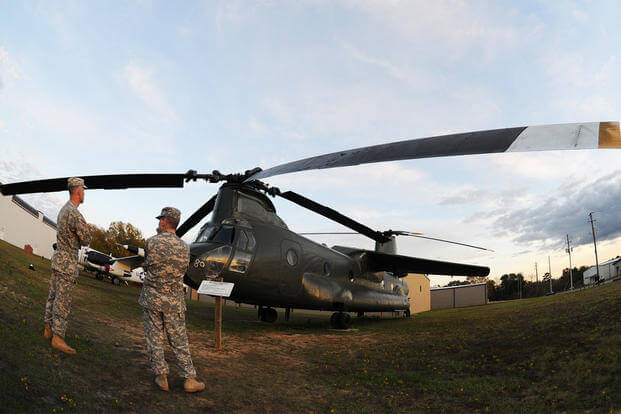FORT RUCKER, Ala. — When one of Fort Rucker's longtime residents needed a facelift in the worst way, a high-priced plastic surgeon didn't rush in to save the day, it was nine Soldiers living the Army value of selfless service through volunteerism.
And the facelift turned out much better than it has for many Hollywood celebrities, but then more than 350 hours under various hammers, scrapers, sprayers, scrub brushes, screwdrivers and Army strong hands of the CH-47 flight engineers from B Company, 1st Battalion, 223rd Aviation Regiment can do great things for a 45-year-old aircraft parked outside at the mercy of Mother Nature's fury year after year.
The almost three-month effort was a life-saving operation, said Bob Mitchell, curator for the U.S. Army Aviation Museum, whose exterior grounds the patient, a BV-347, or winged Chinook, as it is also referred to, calls home.
"This aircraft was in pretty bad shape and I had it on the list to be restored," Mitchell said. "Unfortunately, even though I put 'at risk' on it, it was turned down. And I fretted and worried over that. Like serendipity, Sgt. Hoh (Sgt. 1st Class Jin Hoh, restoration team leader) and his crew showed up, and the next thing I know they're out here pressure washing it, asking for paint and materials, and I'm thinking this is manna from heaven — it couldn't have come at a better time.
"They essentially saved this aircraft," he said. "I just can't say enough about the spirit of volunteers. Without the help of said volunteers, there are a lot of things in this museum that just wouldn't happen. So, again, kudos to everybody and thank you for a job well done."
The kudos went to Hoh, Sgt. 1st Class Xavier Mayne, Staff Sgts. Christopher Durkovic, Kyle Gregory, Eric Hover, Martin LeTang, David Nuss and John Payne, and Sgt. Robert Simpson, who worked on the project from Aug. 8 to Oct. 31.
Hoh and LeTang were already veterans with the aircraft, as they took part in a similar, though less extensive restoration project on the same aircraft in 2011.
"It looked like a rusty can," Hoh said of when he drove past the aircraft after returning to Fort Rucker. "It was sitting out here all rusty and dirty — it was in bad shape. So, I gathered a team together and we did another restoration. Everyone volunteered — without these guys' dedication, it wouldn't have happened."
What happened was a cleaning with a pressure washer, removing the rust, cleaning the windows, painting inside and out, and a reworking of the interior, including the cockpit — although the instruments aren't exactly the ones that were in the aircraft during its operational days, LeTang said.
Several team members intimated that the volunteer effort was a labor of love, and the Soldiers needed that love, and another Army value, personal courage, to even get started, as several colonies of wasps had decided the winged Chinook made a great home.
"You couldn't get within 30 yards without getting stung," Hoh said. But the Soldiers prevailed and now the whole community can enjoy the fruits of their efforts, and Army aviation might even reap some benefits.
"It looks a 100 times better than it did," Hoh said. "[We try] to keep doing stuff for the aircraft and the museum. Maybe kids will come by some day and look at the aircraft, and maybe they'll want to become aviation guys someday."
Simpson, as well, was impressed with the final results.
"We took a lot of time and dedication to get it looking similar to what it was from the pictures," he said. "It took a lot of time, but it was something that we liked to do and wanted to do, it's our love, our passion."
And while they may share a passion for Army aircraft, the team members and co-workers also seem to share a passion for helping out.
"Find something you want to do, something that you can put your heart into," LeTang said, adding that the museum has plenty of other aircraft people can volunteer to help with. "Talk to the curator of the museum and he'll tell you how far can go with it."
Even though museum officials, the team as a whole and the team's company commander, Capt. Lance Garnett, were thrilled with the results of the Soldiers' efforts, that satisfaction would only go so far.
When asked if he'd sign off on the BV-347, LeTang, said "For him to fly it?" pointing at Hover. "Yeah." Hover laughingly responded, "Sure. I'll take it."
The BV-347 was a prototype developed for the Army to test various ideas and components for future heavy lift helicopters, according to museum officials. The BV-347 flew 734 hours from 1970-72. It differed from the CH-47A, most obviously, with the addition of a large set of removable hydraulic wings that could be rotated 90 degrees. It also had a lengthened fuselage, retractable landing gear, longer rotor blades, a higher-aft pylon and a retractable gondola within the fuselage equipped with a set of flight controls — allowing a third pilot to fly the aircraft while facing towards the rear.




























